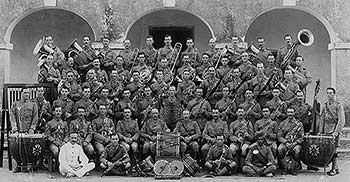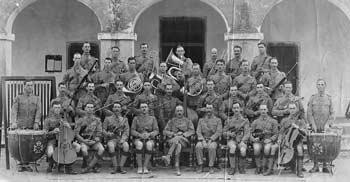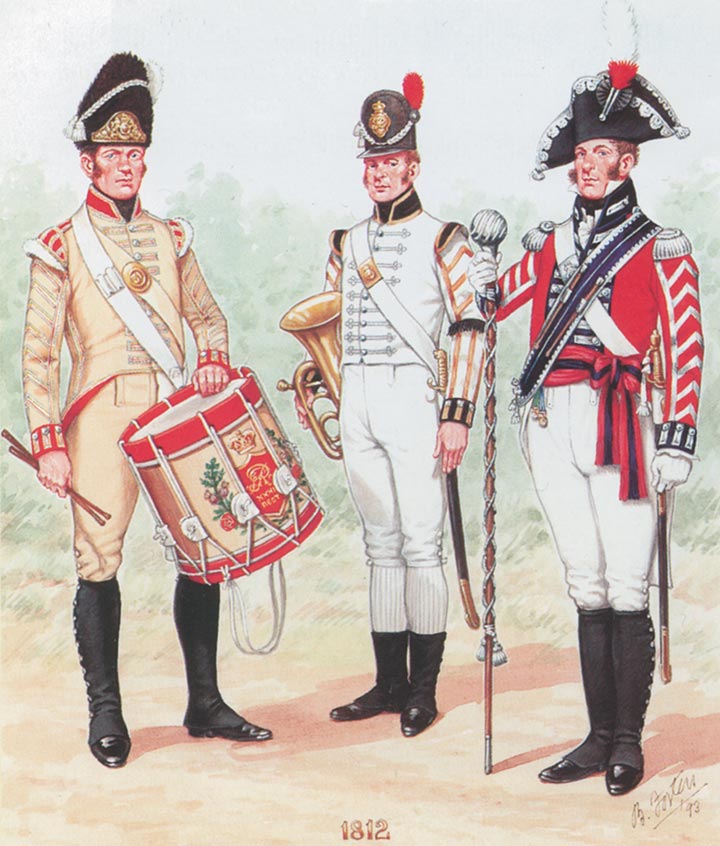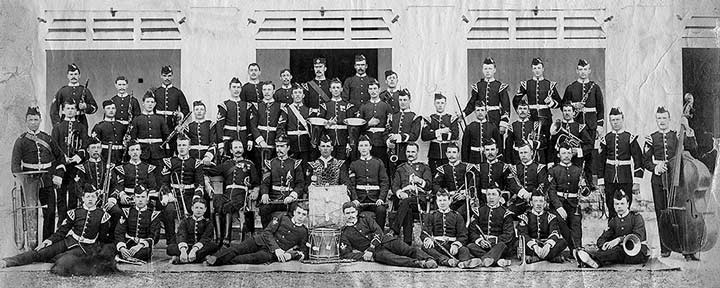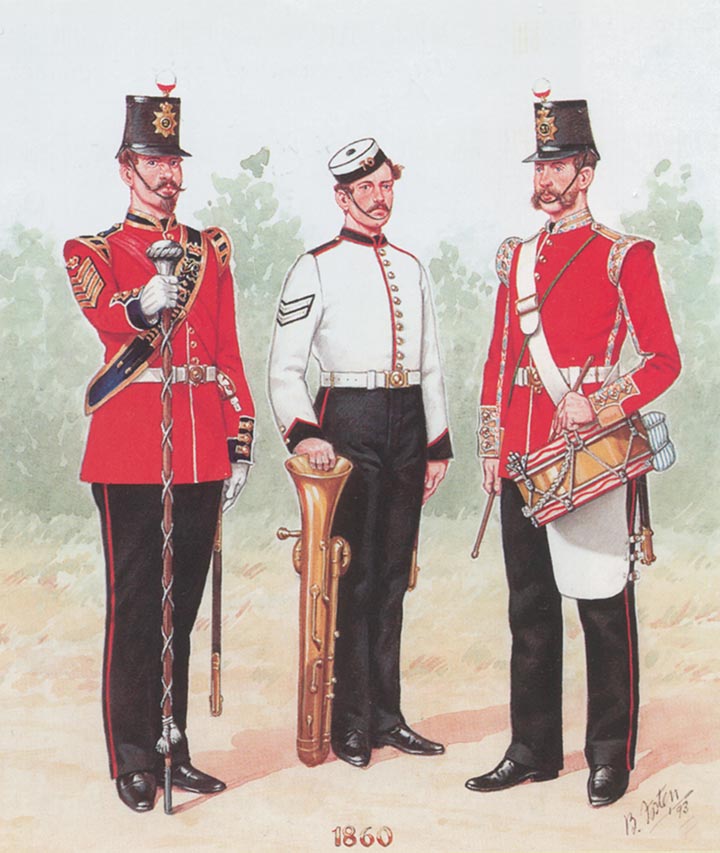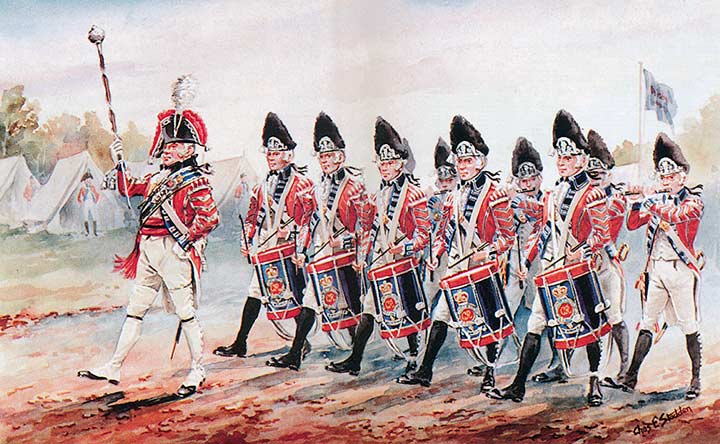Band and Drums Music
Introduction
It would appear that prior to 1881 there were no real Regimental Marches, as we know them today. Regiments marched past to a tune, which was popular with the Commanding Officer, written by the Music Master or Band Sergeant of the day, or popular with the men. In 1883, Regiments were ordered to select a Regimental March and told that it would be promulgated in Army Orders. Regiments had marched to a popular tune for a number of years and this in many cases was the march selected for the Regiment. Certain of our marches fall into this category, but still many mysteries remain as to why some of our former Regiments chose the particular march they did, and why other marches remain in use.
The following pages concentrate on the regular bands and drums, this in no way reflects on our Territorial battalions as most units had a Band and Corps of Drums. Sadly we do not have a complete record of territorial bands. The 1/6th Surreys for example, had a first class-band during the First World War.
'Bonaparte's March' which the 2nd Battalion, the 31st Regiment acquired during the Peninsular War, is obscured by the mists of time. Many regimental historians have tried to discover the background of this march. Popular belief is that it was a French march and was 'taken from the French'. However, a military historian writing to the late Major Peter Hill pours scorn on this and he states:- "Bonaparte's March The question of the music belonging to enemies and allies is an old one and is the subject of many legends and beliefs in the British Army (most of them completely without foundation), and I know this one of the 31st Regiment of old.... The French have been quite meticulous about keeping records of their military music and there is certainly no melody known as 'Bonaparte's March'. But the mystery remains, because in 1874 the book 'Recollections of Sir George B L 'Estrange', late the 31st Regiment, was published and is of interest since in it he refers to a march played by the 31st in the Peninsular War.
"We could distinctly hear the bands of the different French regiments play, and so near that we, could discover the air. I recollect one in particular that we, afterwards discovered from two bandsmen who had deserted and come over to us, and were immediately taken into our band, to whom they taught it. It was called 'Bonaparte's March' and a very fine piece of music it was: I remember the air of it to the present day."
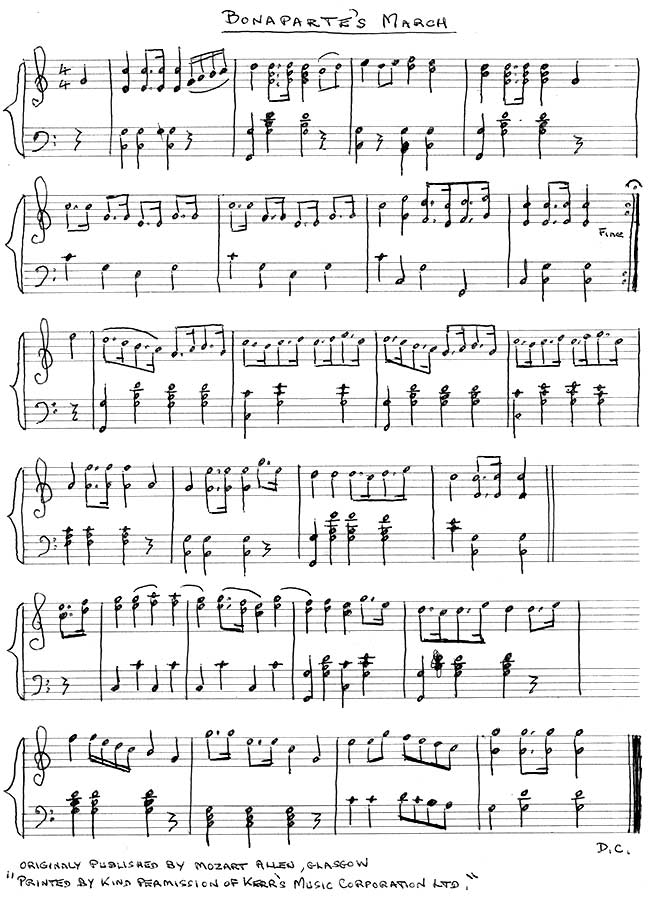
For some years various individuals attempted to obtain the music of 'Bonaparte's Grand March' without success and then Lt Col (Ret'd) Murray wrote to me from his home in Scotland on the 2nd June 1994:-
'Dear Les, Colonel David Murray is the author of the book 'Music of the Scottish Regiments' published in 1999 by The Pentland Press. |
Drummer 31st, The Huntingdonshire Regiment, Bandsman 70th, The Surrey Regiment, Drum Major 2nd, The Queen's Regiment.
The Drum Major of the 2nd and Drummer of the 31st are dressed as nearly to the Regulation of 1803 as possible. At this time Colonels of Regiments took many liberties and Drum Majors in particular were quite often dressed in flamboyant clothing. As far as the drummer is concerned the fur cap was not worn on active service. He would have worn the shako and the coloured plume of his company. Reversed clothing had been authorised in 1768 and continued beyond this period. Although the regimental lace on the buttonholes and seams was determined by Regulation, sleeve decoration was at the discretion of the Colonel. The drum was made of wood with a painted front in Regimental colours.
The uniform of musicians, as opposed to drummers, was not laid down by Regulation. Hence the great diversity shown in contemporary prints. The musician of the 70th is wearing a white jacket, favoured by many Colonels, and decorated with black braid and gold lace. The size of bands varied considerably and Colonels were constantly being ordered to restrict the numbers. Some Colonels lavished vast amounts of money on large bands with a wide range of percussion instruments usually played by 'blackamoors' in exotic dress.
Sir George had good reason to be interested in and supportive of, military music. In 1812, when aged only fifteen but nevertheless newly commissioned, he had to take charge of a party of Irish volunteers being marched from Portsmouth to Ashford, Kent to join his Regiment. Describing them as 'wild Irishmen' he had some difficulty getting them along the route but eventually, mounted on his horse and in the lead, he hit on the idea of playing Irish tunes on his flute. Obviously successful as a one-man mounted band, he arrived safely at Ashford with his charges.
During research into compiling these pages 'Fifty years of Army Music', by Lieutenant Colonel J MacKenzie Rogan, published in 1926, was consulted 'Fifty years of Army Music', is so informative, not only of the music but soldiering of the time Rogan spent with The Queen's. During the time he spent in India he showed considerable interest in Indian music and made good use of it. A quote from 'Songs and Music of the Red Coats' by Lewis Winstock. 'Whilst at Calcutta in 1885 he composed music on Indian themes which were played when the Regimental Band performed at Indian weddings.' It is believed that Rogan was the first to re-arrange for Army bands the well-known tune 'Zachmi Dil, 'The Wounded Heart', which is a Pathan love song which begins:
There's a boy across the river
With a bottom like a peach
But alas! I cannot swim ....
The Band of 1/6th Bn The East Surrey Regiment, Agra, India 1916.
Seated in the picture is the Commanding Officer, Lt Col Hart and the Bandmaster M Chapman.
(Click to enlarge)
Lewis Winstock recalls that this entered the repertoire of the North Staffordshire and Liverpool Regiments which the latter used as an unofficial march. This may be so, but Major Jock Haswell recalls that when he was on the Frontier at the beginning of the Second Word War, the 1st Battalion The Queen's Royal Regiment used it and it was well known throughout the Regiment. The importance of the band in Infantry Regiments cannot be over emphasised. The late Major Dick Smith, an ex-Band Sergeant of The Middlesex Regiment wrote:
"Before mechanisation, a unit marched for miles, sometimes hundreds of miles, behind its Corps of Drums and its Band, and what a brightening of faces and added spring to the step there was once the music struck up. To pay another unit a compliment, the band would be sent to march it into, or away, from the Garrison. At the end of a long and tiring march on one occasion, the Battalion was marching to its encampment by Dhond, in India. It was met by the pipe band of the Rajputana Rifles who played 'Zachmi Dil'. The pipes and the rhythmic beat of the drums had the battalions that had just previously been dog tired swinging along with backs straight and heads erect as if it was just starting a march instead of finishing one of long duration."
(Click to enlarge)
Drum Major 2nd, The Queen's Regiment, Band Corporal 70th, The Surrey Regiment, Drummer 31st The Huntingdonshire Regiment.
The Drum Major of the 2nd and the Drummer of the 31st, are dressed according to the Regulation. Both are wearing the shako of 1856, sometimes known as the 'second Albert' or 'French' shako. The uniforms are as one would expect for this period. Beards and moustaches had been allowed during the Crimean war and the practice continued for some years afterwards. Photographs indicate that, whatever the rank, some intended to go 'over the top' with magnificent whiskers!
Distinctive regimental lace had been discontinued in 1836 except for drummers and this continued until 1866 when universal lace with red crowns was adopted. The brass drum was rather Prussian in style and was popularly called the 'cheese' pattern. The hoops were painted in Regimental colours.
The Corporal musician of the 70th is wearing a white shell jacket and forage cap in undress. In August 1830 a General Order was issued 'for Bands of Infantry Regiments to be dressed in white with Regimental facings'. In dress uniform at this period he would appear similar to the drummer but in white. The white tunic was discontinued, by General Order, in May 1873 when 'Bands are to be dressed in clothing the same colour as that worn by the respective regiments'. The band instrument is the ophicleide which was a successor to the wooden 'Serpent'. It was in turn superseded by the bombardon.
It is a sobering thought that one hundred years ago, within our regular forebear regiments alone there would have been in excess of eighteen Bands and possibly more Corps of Drums. Bands served with distinction in all the conflicts of the last century. Many Bandsmen were awarded gallantry medals particularly for saving lives when acting in their secondary role as stretcher bearers.
In 1984 Bands in the Army reduced in numbers following the cuts of 1981. The one battalion Regiments of Infantry and the Cavalry Bands reduced in size to a Bandmaster and 21 musicians. The larger three battalion Regiments, which were in the Queen's Division opted to reduce their numbers to a Bandmaster and 34 musicians with the exception of the Royal Anglian Regiment who decided to keep three Bands of 21 musicians in each. This meant that the Queen's Regiment and the Royal Regiment of Fusiliers had a total of two Bandmasters and 68 musicians each whereas the Royal Anglian Regiment had three Bandmasters and 63 musicians. The Queen's Regiment Bands were the Albuhera and Quebec respectively. Subsequently the smaller Bands were much less viable.
In 1992 'Options for Change' reduced the Band Service from 1900 to 1133 musicians and discarded the Regimental System for a Divisional System. The Queen's Regiment was disbanded and amalgamated with The Royal Hampshire Regiment to form The Princess of Wales's Royal Regiment with two Bands of a Director of Music and 35 musicians in each. The only Division to keep a Regimental System was the Household Division which maintains five Footguards Bands of a Director of Music and 48 musicians and two Household Cavalry Bands of a Director of Music and 35 musicians. With the Royal Artillery becoming a State Band with identical establishment this increased the number of State Bands to 8. The Light Division opted for the larger size Band and has the same establishment as the State Bands although it remains a Divisional Band. The number of Divisional Bands is 21 and the Ghurka Band remains a Regimental Band. The Corps of Army Music (CAMUS) was formed in September 1992 and is responsible for the recruitment, training and promotions of all musicians in the Corps.
Now, today 2012, the 3rd Bn The Princess of Wales's Royal Regiment has one Band, The Kohima Band a Territorial unit. The regular battalion bands have all disappeared and within The Queen's Division there is but one, the Minden Band. We must rely on our Corps of Drums for our ceremonial, but they too have secondary roles as rifle or machine gun platoons.
These pages are an attempt to place on record our Bands and Corps of Drums, and the important role they have played in our Regiments history in the lives of our officers' and men through the centuries.
The 2nd (Queen's Royal) Regiment of Foot 1792.
(Click to enlarge)
Related
